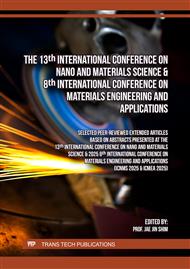p.49
p.63
p.69
p.75
p.91
p.97
p.103
p.109
p.117
Cellulose Derived from Banana Peels
Abstract:
Cellulose is an important structural material found naturally within the cell walls of plants that has recently been researched as a biodegradable, renewable, and non-toxic reinforcing agent used to improve properties for a variety of composite systems. Cellulose is usually derived from wood sources via acid hydrolysis. Bacterial cellulose (BC) is produced by bacteria proliferation using nitrogen, carbon, and oxygen sources, and is similar chemically to plant extracted cellulose. Compared to commercially available cellulose, BC has higher purity and increased hydrophilicity. In this work, banana peels are used as a carbon source for bacterial cellulose growth. The peels were heat treated to maximize sugar and carbon contents. In addition, BC derived from the banana peels doesn’t require any bleaching or chemical post-processing. In this research, BC derived from banana peels is synthesized, characterized, and analyzed for its physical, mechanical, and thermomechanical properties, as compared to commercial nanocellulose.
Info:
Periodical:
Pages:
97-102
Citation:
Online since:
June 2025
Authors:
Keywords:
Price:
Сopyright:
© 2025 Trans Tech Publications Ltd. All Rights Reserved
Share:
Citation:



